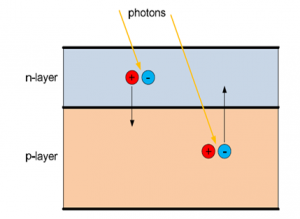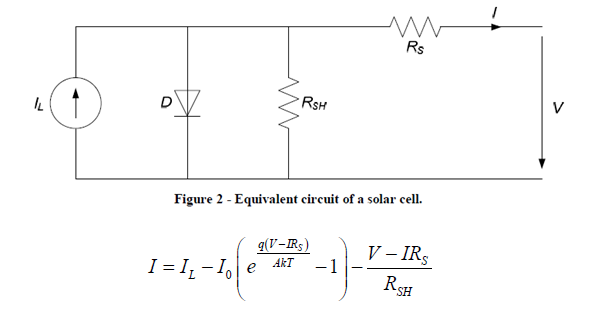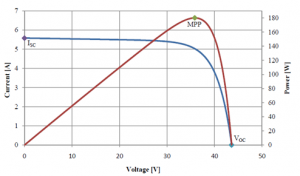Maximum Power Point Tracking (MPPT)
The Solar Panel
Solar panels are basically diodes with n-type silicon on top and p-type silicon layer on bottom. These are some common solar cells:
- Monocrystalline silicon: Monocrystalline silicon solar cells are the most efficient ones. They are made from wafers (very thin slices) of single crystals obtained from pure molten silicon. The efficiency of these cells is around 15-18% and the surface needed to get 1 kW in Standard Test Conditions is about 7 m.
- Polycrystalline silicon: These cells are also made from wafers of pure molten silicon. However, the crystal structure is random: as the silicon cools, it crystallizes simultaneously in many different points producing an irregular structure. Efficiency is lower, around 11-15%.
- Amorphous and thin-film silicon: Amorphous silicon is the non-crystalline form of the silicon and it can be deposited as thin-films onto different substrates.The weak point of these cells is their lower efficiency, around 6-8%.
The solar panel can modelled as a circuit with a current emitter whose current is proportional to the irradiance on it, a diode and some resistors to account for the losses from contacts in circuit (To understand the modelling, you can visit: -https://www.youtube.com/watch?v=rjLd6eJYMsI&t=84s ). Circuit and current law are given below:
The purpose of MPPT
I-V characteristics of solar panels which can easily be visualised as the diode current has a negative sign and IL is constant with specific temperature and constant irradiance of solar panels. ISC is the current when the solar panels are short circuited. VOC is the open circuit voltage of solar panels. This curve is at a constant temperature and irradiance of solar panels. The power extracted from solar panels is also plotted on the same graph with varying voltage or current, there is maxima for a particular Voltage VMPP and Current IMPP. The purpose of a MPPT is to track this voltage for a particular temperature and orientation of solar panels and operate on this voltage for gaining maximum power. The most common algorithms to track this voltage are listed below.
Before introducing the algorithms used a brief introduction of DC-DC converter is needed as it is the backbone of a MPPT.
DC-DC converters are electronic devices that are used to step up or down voltages in a circuit with high efficiencies. It mainly consists of a MOSFET that is switched on and off by a duty cycle applied. The duty cycle(that can be varied) determines the output voltage by the converter. With this background, let's get started with the algorithms.
Algorithms
Hill Climbing technique
Hill-climbing involves a perturbation on the duty cycle of the power converter and a perturbation in the operating voltage of the DC link between the solar panels and the power converter. Examples are Perturbation and Observation and Incremental Conductance. Disadvantage is that the operating point oscillates about the MPP and algorithm takes time to be implemented so implementation in fast changing environment is not efficient. Also these algorithms cannot differentiate between if the change in power is due to change in duty cycle or due to change in irradiation.
- Perturbation and Observation (P&O): A perturbation is made in the duty cycle and power obtained is observed (P=V*I) if power obtained is less than previously observed then the direction of perturbation is changed and vice-versa. This process is repeated until MPP is reached. PW-Sat2 used this technique for MPPT.
- Incremental Conductance: Uses the fact that the: - (del P)/(del V or I) is zero at MPP and have different signs around it, so perturbations are made accordingly. By comparing the increment of the power vs. the increment of the voltage (current) between two consecutives samples, the change in the MPP voltage can be determined.
This page is yet to be completed. Please check back after some days
If you are done reading this page, you can go back to Electrical Subsystem


